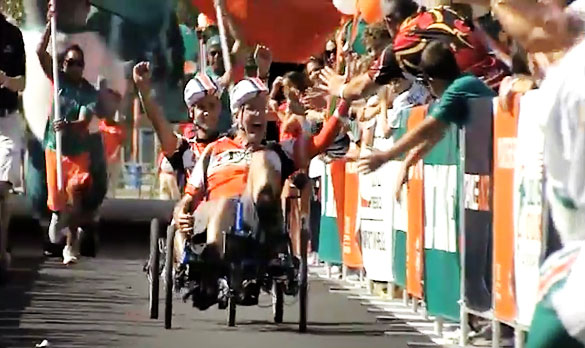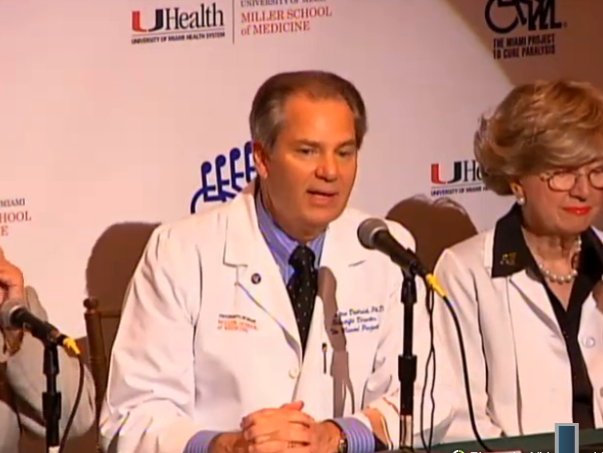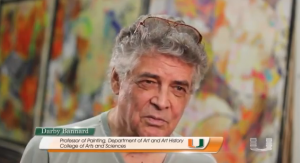Lifesaving research, patient-centric care,
and access to the latest trials and technology
are just a few reasons Sylvester Comprehensive
Cancer Center director Stephen Nimer is bullish
about scoring South Florida’s first and only
National Cancer Institute designation.
BY Robert S. BENCHLEY
Cristina Espinal was an energetic 14-year-old in Colombia who noticed a strange bump on her leg. Carolina Williams, a fit 27-year-old Dallas schoolteacher, woke one morning so bloated she couldn’t button her pants. Miami mortgage broker Eddy Fernandez, an athletic 44-year-old, began needing to nap between meetings. For Matilde Rasco Torres, 68, walking and gardening around her Miami home suddenly became such a chore she thought she had heart problems.
Though strangers to one another, these four individuals share a common bond: They were all diagnosed with cancer, received treatment at the University of Miami Miller School of Medicine’s Sylvester Comprehensive Cancer Center, and have since returned to active lifestyles.
Stephen D. Nimer, Sylvester’s director, says stories like theirs should change the way people in South Florida, and elsewhere, are thinking about cancer—and where to go to have it treated. His outlook is upbeat.
“We are making great strides,” he says. “In the past two years, the Food and Drug Adminis-tration has approved 25 to 30 new drugs for treating cancer. We are turning cancer into more of a chronic disease, so people can live with cancer. We are also beginning to cure some cancers that we were never able to cure before—and that’s the real promise.”

Two years after Cristina Espinal was diagnosed with osteosarcoma, a common form of bone cancer in young people, the teenager is in remission. Her oncologist, John Goldberg, is also director of the Pediatric Oncology Early Phase Clinical Trials Program at Sylvester. Photo by Jorge Perez
WALKING TALL
When 14-year-old Cristina Espinal found a strange bump above her right knee, she went to her family doctor in Medellín, Colombia. The physician thought it might be osteosarcoma, the most common type of pediatric bone cancer. Knowing Espinal’s parents also had a home in Miami, he advised them to take her to Sylvester Comprehensive Cancer Center.
After a multidisciplinary team at Sylvester confirmed the diagnosis of osteosarcoma, John M. Goldberg, assistant professor of Clinical Pediatrics, used chemotherapy to shrink the tumor enough for surgical removal, which saved Espinal’s leg from amputation. A thoracic surgeon then removed some spots on her lungs, a common occurrence with osteosarcoma, says Goldberg.
“I was scared, but the doctors and nurses calmed me down,” Espinal says. “They were always so positive.”
Espinal’s battle with cancer became the focus of her life. She was at Sylvester for tests, treatments, or checkups more than 100 times in a single year. The result, however, was worth everything she and her family endured.
“Medically, Cristina is considered in remission,” says Goldberg, her doctor. “But with each year that passes, the surer we will be that she can look forward to a complete recovery and a normal life.”
Ironically, Espinal’s diagnosis came the same day that her brother, Jorge, was accepted to enroll at UM as a student. Now 16, she wants to follow his footsteps and hopes she’ll be returning to the U soon—this time as a freshman.
“My leg is perfect,” Espinal says. “I can do anything.”
Nimer was one of the world’s premier leukemia and stem cell transplant researchers and clinicians at New York’s famed Memorial Sloan-Kettering Cancer Center when he came to UM in 2012, drawn by a promise that he would have the support needed to gain a National Cancer Institute (NCI) designation for Sylvester.
“President [Donna E.] Shalala and Dean [Pascal J.] Goldschmidt described their commitment to taking Sylvester to the next level,” he says, “and I realized that I could have a huge impact on the lives of the patients who come here. The notion is that we can be an amazingly patient-centric cancer center while doing research that matters—research whose ultimate goal is to bring discoveries in the laboratory to patients as quickly as possible.”
That combination of clinical empathy, a dedication to science, and a commitment to the community is what Dean Goldschmidt sees as the cancer center’s strength.
“Sylvester is unique in South Florida in that our extraordinary physicians and scientists are collaborating every day to develop new therapies, improve those already in use, and get them all to our patients as quickly as possible,” he says. “Bringing that research to the people in our region means our patients receive the most advanced university-based cancer care without leaving home.”
Now Sylvester, South Florida’s sole academic cancer center, is gearing up to apply for NCI designation in 2017. The designation would mean that Sylvester’s work in basic laboratory research; clinical research; and prevention, control, and population-based research is of the highest quality and meets prescribed NCI standards. It would also mean Sylvester has demonstrated substantial transdisciplinary research across those areas.
“In research, the way to show that you work together is to publish together,” explains Nimer. “The research itself takes a couple of years, and then it takes about a year to get it published, so we’re moving quickly.”
Community impact is also crucial to demonstrate. “Part of that is how many people are on clinical trials,” says Nimer, who is also a professor of medicine, biochemistry, and molecular biology at the Miller School. “Over the past 30 months, our enrollment onto clinical trials that involve testing cancer therapies has increased substantially, by roughly 40 to 50 percent each year.”
The NCI designation is more than a prestigious label. It helps the best centers become even better by unlocking doors to additional federal funding and research partnerships. Even the prospect of designation can attract top researchers. These days a savvy generation of patients asks about NCI designation when weighing treatment options.
The halo effect spreads farther still. The Washington Economics Group estimates that the NCI designation for Sylvester would have a $1.2 billion impact on South Florida’s economy over five years and create 200 high-quality jobs.
Those numbers are not lost on Governor Rick Scott and the Florida Legislature, who recently approved a five-year, $300 million budget to support cancer research throughout the state. Of that, Sylvester will receive at least $16 million annually. The funding, which is already helping Nimer hire another 20 to 30 top physicians and researchers, is a significant and deliberate assist in the NCI application process.
“Currently there are 41 NCI-designated comprehensive cancer centers in the U.S.,” Nimer says. “Florida, with a population of more than 19 million—we’re now the third-largest state by that measure—should have three. Instead, we have one—and it’s not in densely populated South Florida. New York, which our state just surpassed in population, has six.”
Compounding the math is the intersection of disease and demography in the Sunshine State. Though No. 3 in overall population, Florida has the nation’s highest percentage of residents over 65—17 percent according to the U.S. Census Bureau—and seniors are cancer’s most frequent targets. The American Cancer Society estimates that Florida will report 114,560 new cancer diagnoses and 42,740 cancer deaths (both No. 2 nationally) for 2014. The Florida Cancer Data System, housed at Sylvester since 1978, projects that around 60 percent of those diagnoses and 70 percent of the deaths will be of people 65 and older.

A chance meeting in Dallas with Sylvester Comprehensive Cancer Center specialist Jonathan Trent has given Carolina Williams, here with son Antonio, hope for continued management of her disease. Photo by Andrew Innerarity
PUTTING CANCER TO SLEEP
Under five feet tall and barely 100 pounds, former Texan Carolina Williams describes herself as “a firecracker.” Yet on January 6, 2006, her spark fizzled. The recently married schoolteacher woke up so bloated she couldn’t button her pants. “I looked pregnant,” recalls Williams, then 27. On her first day back to work after the Christmas break, she felt so ill she had to leave early.
When her husband got home, she was passed out on the bathroom floor.
A CT scan at her local hospital revealed an eight-pound mass that doctors there thought was an ovarian cyst. The initial misdiagnosis led to attempts to puncture and drain the abdominal mass. It was then surgically removed. A pathologist declared the mass benign, but two weeks later a second pathologist determined it was a form of sarcoma called a gastrointestinal stromal tumor, or GIST.
It was through a GIST support group in Dallas that Williams met Sylvester oncologist Jonathan C. Trent, who was in town to receive an award from the group.
“I asked if he would take me on as a patient, and he agreed,” says Williams. “I thought I’d be traveling from Dallas to see him, but my husband got a new job in Miami the following week.”
Trent, professor of medicine, director of the Sarcoma Medical Research Program, and associate director for Clinical Research at Sylvester, monitors Williams’ progress on Gleevec, a drug she’s been taking for eight years to eradicate any residual cancer cells. In that time two other drugs have become available—Gleevec was once the only choice—but Williams will stay on Gleevec as long as it continues to keep her cancer at bay.
Since 2000, says Trent, the average life expectancy for people with metastatic GIST has increased from months to years. “I have patients with metastatic GIST who are alive and doing well 14 years later,” he says. “With perseverance, our laboratory and clinical research into GIST will lead to a better understanding of its cause and, hopefully, result one day in a cure.”
Nimer likens leading Sylvester to running a basketball team, and his strategy is similar: Recruit the best players and focus on your best plays. In just two years, he hired nearly 50 top physicians and scientists from leading institutions, mixing them in with the star players he’d inherited to achieve wins as quickly as possible.
His “best plays” strategy is based on the recognition that cancer is not one but 100 different diseases and that Sylvester’s wins hinge on a realistic playbook.
“We have to get very good at a few things first, then add on, as opposed to having 20 different programs, all of which are getting a little bit better,” he says.
Nimer’s choices include leukemia, lymphoma, and myeloma; sarcoma; genito-urinary cancers (prostate, kidney, and bladder); tumors of the eye and brain; gastrointestinal cancers; head and neck cancers, which includes lung cancer; and breast cancer.
He points out that Sylvester already offers world-class treatment in several of those areas and is achieving five-year survival outcomes that are significantly better than the national average for acute myeloid leukemia (54 vs. 21 percent), late-stage breast cancer (61 vs. 44 percent), and early- and late-stage colon cancer (90 vs. 73 percent and 42 vs. 33 percent, respectively).

Eddy Fernandez has met the challenge of a lifetime with a support team that includes his family and faith, along with a treatment strategy overseen by oncologist Krishna Komanduri. Photo by Andrew Innerarity
A WINNING ATTITUDE
“My daughter Alana, now 5, was only seven months old when I was diagnosed,” says mortgage broker Eddy Fernandez. “She was one of the reasons I was able to battle this.”
“This” is acute lymphoblastic leukemia, or ALL. “It’s most common in children, where it’s highly curable,” says Fernandez’s oncologist, Krishna V. Komanduri, who holds the Kalish Family Chair in Stem Cell Transplantation and is director of the Sylvester Adult Stem Cell Transplant Program. “It’s much more challenging in adults. Eddy had the Philadelphia chromosome-positive version of ALL, which has a poor prognosis and is not curable with chemotherapy alone.”
Fernandez didn’t look like a candidate for serious illness. A careful eater, fitness enthusiast, and triathlete when he wasn’t selling mortgages, he suddenly found he had to take naps between meetings. During his last marathon, in October 2009, Fernandez barely made it across the finish line.
His doctor admitted him to the University of Miami/Jackson Memorial Hospital for tests. However, he needed urgent treatment and didn’t emerge for months. When the ALL was discovered, UM’s hematology-oncology division chief Joseph Rosenblatt, the William J. Harrington Chair in Hematology, told Fernandez’s wife, “We’re going to hit him with everything we’ve got.” That meant chemotherapy, radiation, and, in April 2010, a stem cell transplant.
Komanduri, a professor of medicine and microbiology and immunology, has overseen Fernandez’s transplant and post-transplant care, which has been a marathon of healing—including a bout with graft vs. host disease. But Fernandez, now 49, who once was so weak he couldn’t carry a dinner plate, can finally hold Alana in his arms. He is even strong enough to train for triathlons again.
“In addition to my doctors, I thank God, my family, and my fitness at the time for seeing me through it,” Fernandez says. “All I want now is to cross the finish line.” Fernandez completed his comeback triathlon on September 14.
“Sylvester’s better outcomes are due, in part, to the fact that we have super-specialized doctors,” says Nimer. “We’re also smaller than some of the other cancer centers, so it’s a little easier to pay attention to all the right details, avoid making any mistakes, and make sure patients are treated optimally.”
It may offer little comfort for people who have already lost loved ones, but the statistical truth is that the battle against cancer is slowly being won. In raw numbers, new diagnoses and deaths continue to grow, but that’s because the U.S. population continues to grow, and with it an increasingly large percentage of seniors. According to American Cancer Society statistics, the average five-year survival rate for all cancers, races, and ages in the U.S. has risen from 49 percent in the 1970s to 68 percent today. Those numbers bear out what Nimer has seen in his own clinical practice.
“Multiple myeloma, a disease I treat, is a great example,” he says. “If you developed it 10 years ago, your average life expectancy was three or four years. Now it’s five to eight years, so it has doubled in a decade. While that’s clearly not good enough, it is important progress, especially because the treatments have become much less difficult.”
There are also more cancer survivors than ever before—14.5 million, according to the American Cancer Society—a number expected to exceed 19 million by 2024.
To speed translational results, Sylvester has begun research collaborations with Memorial Sloan-Kettering, Nimer’s former institution, and with the giant University of Texas MD Anderson Cancer Center in Houston, from which a number of his star recruits have been drawn. Inside the Miller School, Sylvester is working with the Diabetes Research Institute, the Interdisciplinary Stem Cell Institute, the Department of Neurological Surgery, and the John P. Hussman Institute for Human Genomics. The Miller School’s Dr. John T. Macdonald Foundation Department of Human Genetics now includes the newly created Cancer Epigenetics and Genomics Program. Elsewhere within UM, Sylvester is teaming up with the School of Nursing and Health Studies and the School of Communication to improve its health disparities outreach programs and messaging to affected populations.
Sylvester is also expanding its service regionally by opening satellite clinics, most recently in the Broward County cities of Plantation, Hollywood, and Coral Springs. Still to come is The Lennar Foundation Medical Center, a large outpatient facility slated to open in 2016 on the Coral Gables campus.
Nimer says he enjoys his role at the helm of all these transformative initiatives. “Leadership positions give you a wonderful way to help others,” he says. “It’s a great responsibility, but we’re gearing up to do great things.”
Departing from his earlier basketball imagery, Nimer concludes, “We want to be thought of as the Tiffany’s of cancer care. When you come here, you know you will get a wonderful product.”

Matilde Rasco Torres and her husband of 43 years credit Sylvester Comprehensive Cancer Center physicians Ronan Swords, pictured, and Lazaros Lekakis with having saved her life. Photo by Andrew Innerarity
A SECOND OPINION GIVES A SECOND CHANCE
While vacationing with her husband, Luis, in Georgia in 2012, Matilde Rasco Torres, then 68, began to feel weak and short of breath.
“I thought it might be my heart,” she recalls. But a visit to her family doctor back in Miami revealed a low hemoglobin level. A local oncologist put her on an oral medication for myelodysplastic syndrome, or MDS, a type of cancer in which the bone marrow does not make enough blood cells.
“Instead of getting better, I quickly began getting worse,” says Torres. She and her husband went to Sylvester for a second opinion. There she was placed under the care of Ronan T. Swords, who is the Pap Corps Endowed Professor in Leukemia. After analyzing her bone marrow cells in much greater detail than the original exam, Swords estimated that unless her course of treatment was changed, Torres had only four or five months to live. He recommended a medication called Vidaza. After four treatments, she was in remission.
“Vidaza is not a cure,” emphasizes Swords. “The remission can last from weeks to months, but the MDS will come back, so I recommended that we do a bone marrow or stem cell transplant.”
Lazaros J. Lekakis, assistant professor of clinical medicine, supervised Torres’s care before, during, and after her bone marrow transplant. Now 70, she’s able to enjoy taking walks and gardening again, and is even considering doing volunteer work.
“The doctors at Sylvester were always available, kept us informed, and they really cared,” says Torres. “I never knew we could have such wonderful relationships with our doctors. I’m convinced I would not still be alive if we hadn’t come to Sylvester. To beat a disease like cancer, you need this kind of support.”
Robert S. Benchley is senior editor at the University of Miami Miller School of Medicine.


 Follow
Follow








